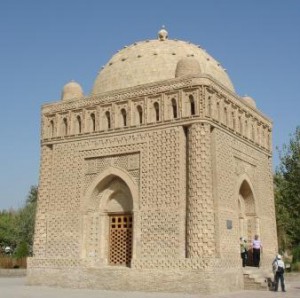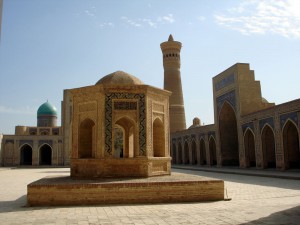The almond groves of Samarcand,
Bokhara, where red-lilies blow,
And Oxus, by whose yellow sand
The grave white-turbaned merchants go…
Oscar Wilde
There is no doubt that Bukhara remains one of the most romantic cities anywhere in the world. Its beauty has much to do with the city’s fascinating architecture from various periods and its rich cultural heritage going back almost 25 centuries.
Sacked with steady regularity by rampaging raids of foreign rulers from the Persians through Alexander to Genghis Khan, Bukhara, however, survived and outlived the depredations of the invaders of the past to become one of the great Central Asian khanates in the 17th century.
With hundreds of mosques and just as many madrassahs in the city, Bukhara was laying good claim of being the holiest city in the world. Bukhara hasn’t changed a great deal in centuries, and today there’s so much fantastic architecture littering the city, that visitors can simply walk around the old town and soak up building after building, or meander through the back alleys checking out carpet weavers, blacksmiths and various other artisans at work.
Religion, royal power and trade – the cornerstones of Bukhara’s existence – each one has left the city a legacy of stunning architecture.
 The oldest and most breathtakingly original building in Bukhara, which survived Mongol invasion, is Ismael Samani mausoleum. Built in early 10th century for the founder of Samanid dynasty, the mausoleum represents unique patterns of basket-woven masonry which make the massive walls of the mausoleum look weightless.
The oldest and most breathtakingly original building in Bukhara, which survived Mongol invasion, is Ismael Samani mausoleum. Built in early 10th century for the founder of Samanid dynasty, the mausoleum represents unique patterns of basket-woven masonry which make the massive walls of the mausoleum look weightless.
The major focus for visitors to Bukhara is The Ark. Home to the rulers of Bukhara for over a millennium, the Ark is as old as Bukhara itself. The initial fortress dated back to antiquity and was rebuilt many times to get it present form in the 16th century, when it became not only the residence of local emirs (with harem, thrown room, reception hall) but also housed a whole range of government accessories, including treasury, gold mint and dungeon which today displays some of the torture methods employed by the Emirs against their enemies.
Just across the square lying at the foot of the Ark there is a picturesque complex of the palace Jami mosque and the Bolo-Hauz mosque (1712) whose elegantly carved wooden pillars and minarets reflect in the nearby pool.
 Of special interest in Bukhara is the Kalon Minaret wrapped in ornamental bands. Once the tallest structure in all of Central Asia it towers the city at 47 meters. Built in 1127, the minaret managed to survive both the test of ages and marauding invasion of Genghis Khan who, as popular legend says, was so dumbfounded by the beauty of the this stupendous minaret that he spared it when he sacked Bukhara.
Of special interest in Bukhara is the Kalon Minaret wrapped in ornamental bands. Once the tallest structure in all of Central Asia it towers the city at 47 meters. Built in 1127, the minaret managed to survive both the test of ages and marauding invasion of Genghis Khan who, as popular legend says, was so dumbfounded by the beauty of the this stupendous minaret that he spared it when he sacked Bukhara.
What makes Medieval Bukhara architecture peculiar is the layout of its monumental structures. Traditionally, the constructions had to form an architectural complex rather than a detached building. Minaret Kalon actually is the focal structure of stunning trio of buildings flanking the city’s central ensemble – Poi Kalon square. The other two constructions of the ensemble are a grandiose Friday mosque Masjidi-Kalon and the still-functioning Miri-Arab Madrassah, both dating to the 16th century.
Similar approach of structural integration can be witnessed in Lyabi-Hauz ensemble. Here, the big pool, trimmed with slabs, is surrounded by several buildings: the sixteenth-century Kukeldash Madrassah (the biggest madrassah in Central Asia), a khanaka (a hospice for dervishes) and Nodir Divan Begi Madrassah, both dating back to the 17th century. For centuries, Lyabi Hauz pool provided the city with drinking water from the Shakhrud canal; today Lyabi Hauz is one of the favorite places for local people to relax in the shade of age-old trees.
Undoubtedly, one of the main places of interest in Bukhara is Ulugbek’s Madrassah which has been fascinating the visitors with its elegant form and ornamentation since the 15th century when it was built by Timur’s grandson. Facing this structure is the seventeenth-century Abdulaziz-khan Madrassah with equally impressive décor.
A similar ensemble is formed by the Modari-khan and Abdullah-khan Madrassahs, built opposite each other in the narrow street.
Trade has been the lifeblood of this city for centuries. Sitting directly at the crossroads of the great trading routes of the Silk Road, Bukhara hosted caravans of traders laden with goods from all points of the compass. No wonder there were in the city numerous caravanserais, baths and multi-domed market buildings. Some of them, Taki-Zargaron, Telpak-Furushon and Taki-Saraffon are now preserved as shopping malls and just as they did in the past these arcades trade carpets (a trademark of Bukhara), silks, embroidery, jewelry and spices in a time-honoured tradition dating back centuries.
In 1993 UNESCO recognized the value and significance of Bukhara cultural and architectural legacy and the historic centre of Bukhara was inscribed in the UNESCO World Heritage List.
